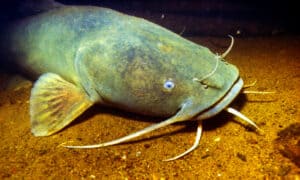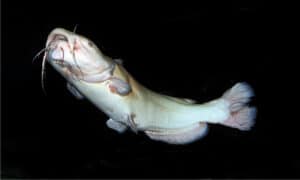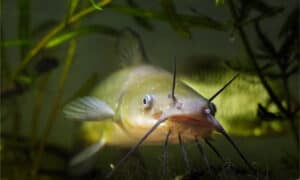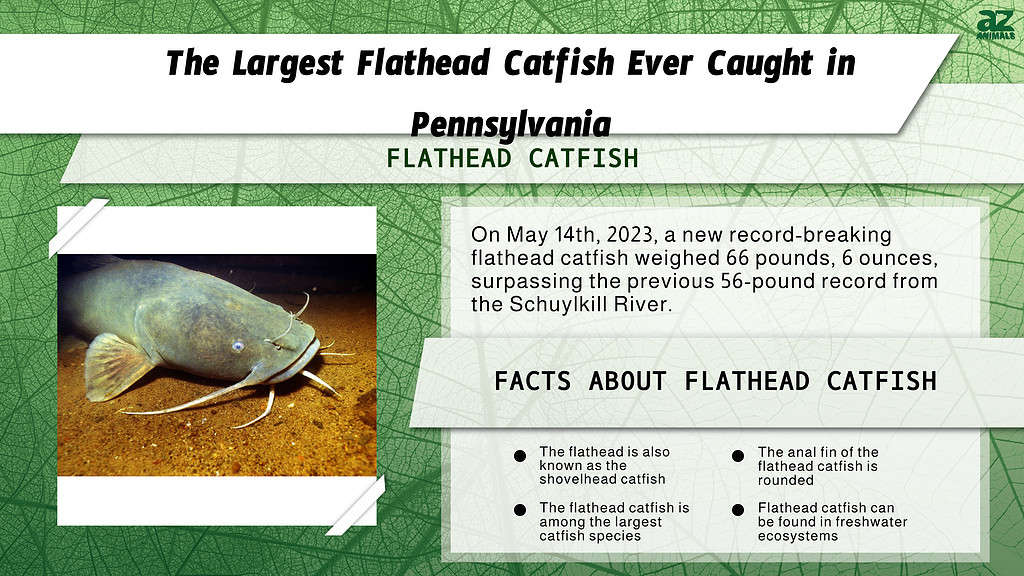
By far the largest freshwater fish ever recorded in Pennsylvania is its record flathead catfish. Using live rainbow trout as bait, local angler Michael Wherley and his friend Walter Clark reeled in three huge flathead catfish out of the Susquehanna at the same time.
The first two, weighing around 30 and 45 pounds respectively, were impressive in their own right. The third fish, however, was something truly special.
That morning, Sunday, May 14th, 2023, Wherley landed a record-breaking flathead catfish that weighed a whopping 66 pounds, 6 ounces. A flathead cat from the Schuylkill River, weighing 56 pounds, 3 ounces, had previously held the record for three years. This goliath dwarfs the previous record-holding specimen by more than 10 pounds!
About the Flathead Catfish (Pylodictis olivaris)
To put Wherley’s incredible catch in better perspective, let’s look at the flathead catfish as a species. We’ll learn how big they get on average and find out about the biggest flathead catfish in the world. We’ll also learn where they live, what they look like, and what they eat that allows them to reach such impressive sizes!
General Appearance
The flathead, or shovelhead catfish, is named for its remarkably wide, flat head. It has a large mouth with a protruding lower jaw, giving it a prominent underbite.
The fish also has eight whisker-like barbels — two on the top jaw, four on the lower jaw, and two on either side of its large mouth. These help the fish locate food at night or in murky water. They also help it detect obstacles in its path, much like the whiskers of a cat.
Like the channel catfish, juvenile flatheads often exhibit different coloration than adults. Typically, adult fish are a light yellow, yellow-brown, or olive green and exhibit heavy, dark-colored mottling. This helps them blend into murky water and the sandy or silty bottoms of their habitat. Juveniles, on the other hand, are frequently very dark brown or black in coloration.
Besides its characteristic underbite, several traits can help differentiate a flathead catfish from other catfish species. The tail fin, for instance, is completely round or only gently notched, whereas the tail fin of the channel catfish is pointed and deeply forked.
The anal fin of the flathead catfish is rounded as well and contains much fewer rays than those other catfish. Where a channel catfish will always have between 24 and 29 rays in its anal fin, flathead catfish will only have 14 to 17.
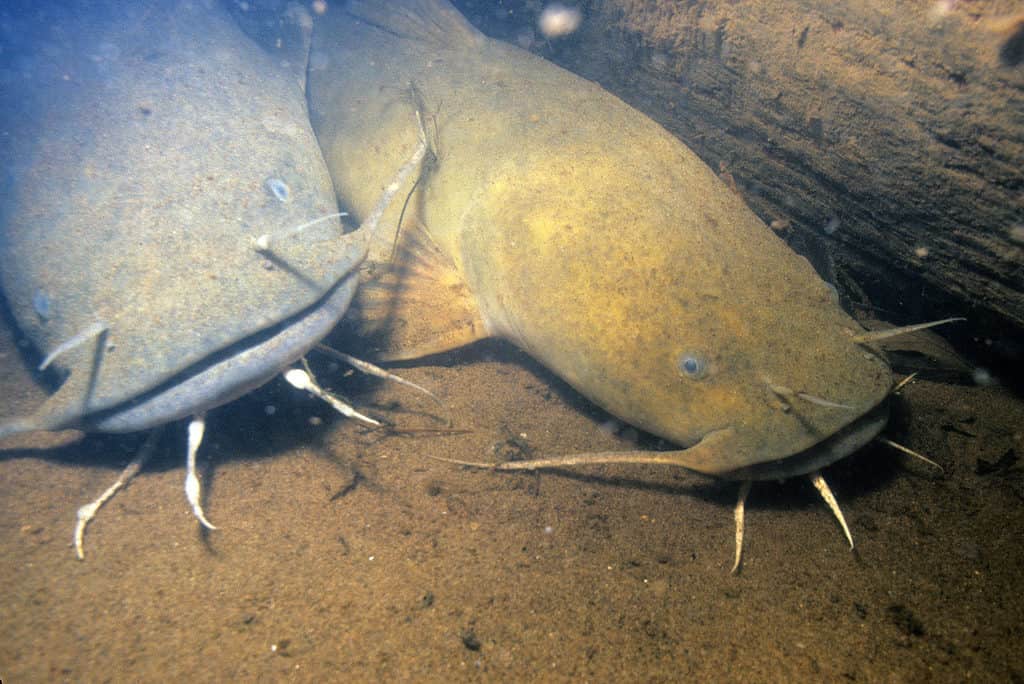
These catfish can vary in overall color but are easily identified by their wide, flat head and jaws.
©iStock.com/stammphoto
Average Size
The flathead catfish is among the largest catfish species in Pennsylvania. Specimens weighing between 20 and 30 pounds are fairly common. Though, as the record-holding fish demonstrates, they can grow much larger in some circumstances. Michael Wherley himself is even convinced that there are bigger flatheads than his in the state.
That said, the largest flathead ever caught blows Pennsylvania’s record cat out of the water! In 1998, a Kansas angler pulled in a flathead weighing an insane 123 pounds! That’s just more than double the weight of Wherley’s catch — a true testament to the gargantuan sizes these fish can achieve when given the chance.
Diet
Catfish in general have quite a unique relationship with their food, and the flathead cat is no exception. These animals are covered mouth-to-tail in tastebuds, allowing them to taste their surroundings.
This unique trait gives them quite a fin-up in low-visibility conditions, where they can detect and distinguish between different types of prey based on the amino acids they release. Their external tastebuds also help them track down prey in motion.

Flathead catfish will eat just about anything they can fit into their massive mouths, including snakes and birds!
©stammphoto/ via Getty Images
As sensitive as these animals are to their food, they are not picky about what they eat. Many people refer to catfish as living stomachs as they will eat just about anything they can fit into their mouths. This dietary flexibility is a big part of what allows these fish to grow so large.
When young, flathead catfish feed primarily on invertebrates like worms, larval insects, and small crayfish. As they grow, so does their appetite. Adults will feed on whole fish like carp, small catfish, and sunfish like bluegill and largemouth bass. Larger adults will even go after unsuspecting snakes, rodents, and birds that may have chosen a bad time for a swim.
They’ll even eat other flathead catfish!
Range and Habitat
Flathead catfish can be found in freshwater ecosystems like creeks, rivers, ponds, and lakes, throughout most of the United States. Though they will hunt in most parts of the water column at night, they prefer to rest in the cool water at the bottom during the day.
They tend to hole up beneath snags, logs, rocks, and dense vegetation most of the time, especially during the summer mating season. Flatheads are quite adaptable and, because of their generalized diet and fast rate of reproduction, have quite easily established populations outside of their native range.
While the eastern extent of their range was once limited by the Appalachian Mountains, these fish have been introduced by humans into East Coast waterways over the last several decades. Today, they can be found from Florida to eastern Pennsylvania and southern New York. They even reside in the Great Lakes.
Their range has expanded westward, too. These fish were once endemic to the Mississippi River basin and parts of the Missouri, with a western range spanning from North Dakota to northern Mexico and southern Texas. With human introduction, however, flathead catfish now appear in waterways in every U.S. state westward of the Mississippi. In some states, where these fish readily outcompete native species, they are considered invasive.

The native range of the flathead catfish was once limited to the orange area on the above map. Because of their popularity as sport fish, humans have introduced them to nearly every U.S. state.
©U.S. Geological Survey / Public Domain – License
The photo featured at the top of this post is © Jayce Wyatt Photography/Shutterstock.com
Thank you for reading! Have some feedback for us? Contact the AZ Animals editorial team.



